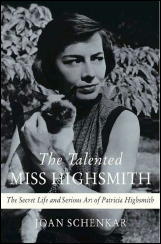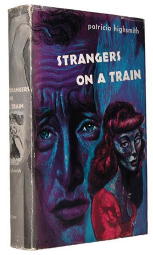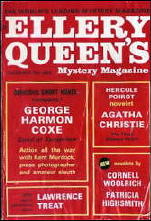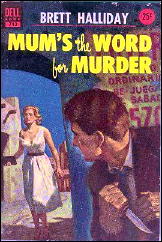Tue 22 Jun 2010
Mike Nevins on PATRICIA HIGHSMITH, CORNELL WOOLRICH and “Mum’s the Word.”
Posted by Steve under Authors , Columns[9] Comments
by Francis M. Nevins
Of all the authors who in the years after World War II moved mystery fiction “from the detective story to the crime novel,” perhaps the most influential American woman was Patricia Highsmith (1921-1995).

Certainly she’s the only one to have received so much critical attention after her death: first Andrew Wilson’s biography in 2003, more recently Joan Schenkar’s The Talented Miss Highsmith, which isn’t a conventional biography but more an exploration of Highsmith’s obsession-torn mind and emotions and how they spilled over into novels like Strangers on a Train and The Talented Mr. Ripley.
If you think Cornell Woolrich was something of a psychopath and a creep, you don’t know the meaning of those words till you’ve encountered Highsmith.
Both, of course, were homosexual. I gather from Schenkar’s book that Highsmith, who was born in Texas and came of age in the feverish New York of the World War II years and went through lovers with the fury of a Texas twister, was never terribly comfortable with being a lesbian.
Woolrich was perhaps the most deeply closeted, self-hating homosexual male author that ever lived. Both wound up worth several million but often acted as if they were penniless. Both lived mainly on booze, cigarettes and coffee, with peanut butter added to the diet in Highsmith’s case.

Both bequeathed their copyrights and other property to institutions, not human beings. Woolrich left an autobiographical manuscript (Blues of a Lifetime) which is full of obvious fiction; Highsmith left 8000 pages of notebooks which, as Shenkar demonstrates, are also pockmarked with falsifications.
But there were notable differences too. Just to mention one, Highsmith was fixated on possessions, keeping everything (except any paper trail leading back to the seven years she had spent in her twenties writing scripts for comic books like Spy Smasher and Jap Buster Johnson), while Woolrich kept nothing, not even copies of his novels and stories.
It’s most unlikely that the two ever met. Woolrich read very little crime fiction but appeared regularly in Ellery Queen’s Mystery Magazine in the Fifties and Sixties and may have read Highsmith’s EQMM stories.
We know she read the magazine steadily and, in her book Plotting and Writing Suspense Fiction, devoted almost a full page to Woolrich’s “Murder After Death” (EQMM, December 1964).

Why did she single out this rarely reprinted and never collected tale? Perhaps she saw something akin to her own evil protagonists in Georg Mohler, a loser at the game of love who turns to crime for emotional revenge.
When the wealthy and lovely Delphine rejects him for law student Reed Holcomb and then dies a sudden but natural death, Mohler concocts a laughably dumb plot to sneak into the funeral parlor, inject poison into her body and frame Holcomb for murder.
Woolrich’s detail work is sloppy and implausible and his climactic twist, like those in several of his earlier stories, comes straight out of James M. Cain’s The Postman Always Rings Twice. But the scene where Mohler hides in the funeral home and posthumously poisons his lover’s corpse is a gem of poetic horror.
If any single element in the tale deserved Highsmith’s attention it was this one. In fact she spent most of the page summarizing the plot, calling it a “quite well-done gimmick story” with “an elaborate but quite entertaining and believable scaffolding….” Go figure.
It was a gimmick—the two men in Strangers on a Train (1950) agreeing (or did they?) to exchange murders — that first made crime fiction readers (not to mention Alfred Hitchcock) take notice of the not yet 30-year-old Highsmith.

Later authors including Nicholas Blake and Fredric Brown worked their own variations on the theme. But who remembers its first appearance in the genre?
Mum’s the Word for Murder (1938) uses very much the same gimmick, although here it involves three murders, not two, and is saved till the solution rather than employed as a springboard.
The byline on this long-forgotten book was Asa Baker but the author’s real name was Davis Dresser and his best-known pseudonym was Brett Halliday, which he used for the all but endless adventures of Miami PI Michael Shayne, beginning in 1939, a year after Mum’s the Word came out.
As chance would have it, much of both novels is set in Texas, where both Dresser and Highsmith spent several of their formative years.
June 22nd, 2010 at 4:45 pm
I’ve asked Mike if he was aware of one specific time that the paths of Woolrich and Highsmith crossed, in a matter of speaking.
It’s visible in the cover of that December 1964 issue of EQMM that Mike brings up. In the same magazine in which Woolrich’s “Murder After Death” appears is a story by Patricia Highsmith, “Another Bridge to Cross.”
Pure chance?
June 22nd, 2010 at 5:33 pm
I wonder how this Highsmith bio adds to the previous good one, from about five years ago?
June 22nd, 2010 at 5:52 pm
A good question, Curt.
As I understand it, and Mike hints at this in his second paragraph, Schenkar’s book takes a different approach (same subject, of course) and rather than a chronological retelling of her life, tries to put various aspects of her life together as separate themes, and then connects these themes up with the books she wrote.
Too many biographies of mystery writers go through their subject’s lives in considerable detail, but not knowing the field, skip over too lightly the questions that mystery readers would like to ask, which is why the authors wrote the kinds of books they did.
I may be wrong about this in Highsmith’s case, not having read either book, unfortunately, only having read about them.
If Mike has more to say, I’ll post it here.
June 22nd, 2010 at 6:36 pm
Interesting that while there are plenty of sane mystery writers there seems to be a branch of suspense that is obsessed, tormented, and miserable — Highsmith, Woolrich, Thompson, Goodis … I suppose they wrote from that dark place because they lived it, but you have to wonder what their work might have been like if their lives had been less dramatic, traumatic, and dark.
June 22nd, 2010 at 6:55 pm
I thought the first book was quite interesting, don’t know whether I should get this one.
Highsmith was a very interesting, if rather repellent, person, at least judging from the first bio.
June 23rd, 2010 at 5:50 am
I’ve always found Highsmith a variable commodity–sometimes compelling, often merely turgid–lacking the lurid poetry of Woolrich’s purple prose, but I intend to check out this bio. Thanks, Mike!
June 23rd, 2010 at 12:15 pm
Re the EQMM connection between Cornell Woolrich and Patricia Highsmith, that being the December 1964 issue, Mike says:
“According to Joan Schenkar, with whom I’ve been having a lively exchange of E-mails lately, Highsmith wrote Plotting and Writing Suspense Fiction in a single month. I wouldn’t be surprised if she had a copy of the December 1964 EQMM at hand and discussed the Woolrich story in it simply because it was convenient.”
And regarding the two Highsmith biographies, he says that, and this is very nearly a direct quote also, I phrased the difference between Wilson’s book and Schenkar’s very well.
Good. Now perhaps I should read them!
— Steve
June 23rd, 2010 at 4:08 pm
I’m not sure I have enough interest in Highsmith to read both the books (they are both quite long too), but I think everyone should read at least one of them!
To be honest, I’m not much of a fan of her writing–she’s too inhuman for my taste!
July 3rd, 2010 at 6:55 am
Okay, I’m about a third of the way through, and so far, it’s more entertaining than most of Highsmith’s books themselves. Schenkar’s unspoken thesis seems to be that Highsmith was a difficult woman, but not a tragic one. Yeah, she smoke, drank, didn’t eat right and maybe she never found True Love, but she died successful and well-respected, living the life she wanted to live. Schenkar also deals very knowledgeably with the Golden Age of Comic Books and Highsmith’s role in it. And I like her agreeably scatter-shot approach to biography: no long chapters about childhood, school, etc. but everything related in a word-association style that keeps jumping in lively fashion from point to point in Highsmith’s life. I’m having a good time with this!